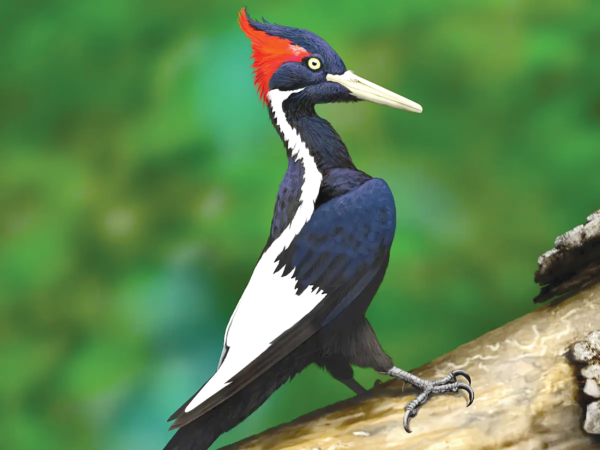As an avid outdoorsman and a wildlife artist, I am obviously very interested in our surrounding wildlife, and I like to keep tabs on what’s happening in the wildlife community. Recently a story on the possible sightings of Ivory-billed woodpeckers caught my attention. Understand that Ivory-billed woodpeckers were never a part of Pennsylvania’s wildlife, but rather, they inhabited the extreme southeastern part of the United States. I use the past tense term “inhabited” because the last universally accepted sighting was in Louisiana in 1944, and in 2021, the U.S. government declared the species to be extinct.
The Ivory-billed woodpecker was considered the largest woodpecker in the United States; it was about 20-21 inches in length and had a wingspan of 30 inches. As the name implies, it had an ivory-colored bill that flattened toward the tip. It was shiny black with white lines extending down from the checks. The male displayed a triangular-shaped red crest at the back of the head, while the female had no red and was all black. Their diet consisted of large beetle larvae, vegetable matter, and fruit, like pecans, acorns, hickory nuts, and wild grapes.
The elusive Ivory-billed woodpecker preferred the bottomland hardwood forests and was often found high up in the tops of trees. Due to heavy logging and unregulated hunting by collectors, it is believed the woodpecker was eventually wiped out. But now, getting back to what I mentioned at the beginning of this article, a recent story caught my eye. In summary, it’s been reported that in May of 2023, a team of researchers and nature enthusiasts presented images from drone videos, trail cameras, and audio recordings, suggesting that the Ivory-billed woodpecker may still be in existence. All very interesting, but I should point out that not all of the scientific community is on board with what’s been presented.
It remains to be seen if the Ivory-billed woodpecker is still in existence, but in the meantime, we actually have a pretty large similar-looking woodpecker of our own right here in Pennsylvania, and it’s called the Pileated woodpecker. The Pileated woodpecker has sometimes been mistaken for the Ivory-billed woodpecker, but the Pileated woodpecker is smaller and about the size of a crow; it also has more white markings on the head and underside in the neck area. Considering its large size and its loud, noisy flight pattern, it is seldom spotted by most people. In fact, if you talk to some people, they may well tell you they have never seen one.
One of the reasons you seldom spot a Pileated woodpecker is, like the Ivory-billed woodpecker, they too prefer the more heavily forested areas and tree tops, although, in recent years, they are showing up more and more in the suburbs and less forested areas. These woodpeckers are year around residents, and many of my own sightings have occurred while deer or turkey hunting in the big timber.
Keep your eyes open, and hopefully, you will get a look at our Pileated woodpecker; if you spot an Ivory-billed woodpecker, however, you will probably go down in history.




